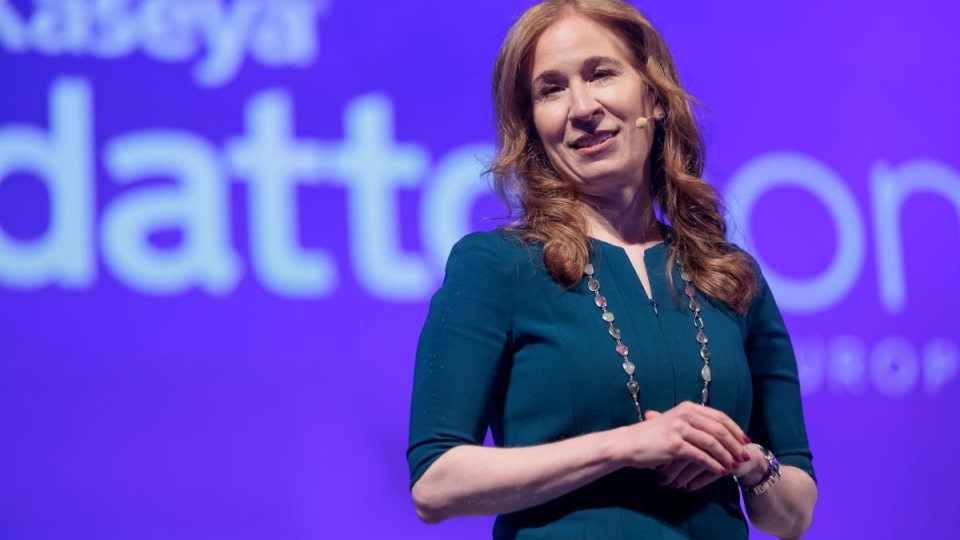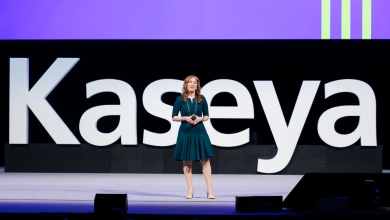
Just two weeks into her tenure as CEO of Kaseya, Rania Succar stepped onto the DattoCon Europe stage in Dublin with a message that balanced strategic continuity with renewed urgency. While praising the company’s existing foundation, she made it clear that the next chapter would be driven by discipline, data, and a sharper focus on outcomes.
“We’ll run the company based on metrics so we can hold ourselves accountable,” she explained in our interview following her keynote. “When we say we're going to focus on customer outcomes above all… the metrics that matter are profitability, revenue growth, and then the end customer impact—we can measure all of that.”
Those metrics aren’t abstract. Succar pointed to examples like measuring endpoints per technician or the percentage of tasks automated. “We could look at endpoints per technician, and we could make a goal to make that the absolute best in the industry. If we believe that the share of automation translates into profitability, we can look at what share of all tasks that our small businesses are doing are automated.”
Even Kaseya’s internal functions are being retooled. “We have an opportunity to ensure that our account managers are also working to increase the profitability and revenue of their customers,” she said. “They are today, but we can formalize it with more formal measurement to ensure that happens.”
That pursuit of impact was also central to her view on Kaseya’s increasingly competitive pricing. In the past year, the company has introduced bundled offerings at aggressively discounted rates, prompting mixed reactions from the MSP community and rival vendors. Succar left no doubt about the motivation.
“We’re committed,” she said plainly. “The reason we came out with that pricing was because we wanted to help MSPs become more profitable. The key message we delivered… was that MSPs had a very low margin despite their critical value to SMBs. We wanted to play a major role in helping improve that.”
She cited internal benchmarking showing significant advantages for Kaseya partners: “We said they tend to be 20–30% more profitable. That could come from pricing advantage. It could come from efficiency, because their much higher cost is labour. And if we can allow them to scale without adding labour, their margins go up.”
Succar also addressed the large swathe of the MSP market still hesitant to adopt professional toolsets. “It comes down to change management,” she noted. “They're busy. To adopt new tools, they have to research them. That's exhausting. You have to make onboarding incredibly simple and straightforward.”
Design, she argued, plays a critical role in making software adoptable. “If onboarding is 15 clicks, or can we deeply understand you with just a few pieces of information? Can we immediately figure out what you want to do with the software and point you there—versus have you try to click around and be overwhelmed with the 50 different things the software can do?”
That philosophy also shapes her thinking on artificial intelligence. Despite market hype, Succar says real-world adoption among MSPs remains patchy. “Adoption has been much slower than anyone expected,” she said. “There's a lot of work to do to fix the data layer so that AI can be effective… but the even bigger reason is change management.”
She added that even high-value use cases like engineering copilots are underused due to lack of time, not lack of interest. “When you're busy in your day job… where are you going to find the time in the day to pause and play around with AI and see what's possible?”
For Kaseya, that creates both a challenge and a responsibility. “We hold ourselves accountable to driving automation for our MSPs. It's the only way we're going to hit our growth and profitability goals. So we must invest in the training, and we must make it so intuitive and so part of their workflow that they turn it on.”
While Kaseya remains firmly a software business, Succar acknowledged that support and services are increasingly important. “When you're dedicated to outcomes for your customers, you need to have both,” she said. “You need to lead with technology, and you need to ensure that that technology is adopted… some of it comes from change management. And that’s what we can support through services.”
Asked whether Kaseya might go further and develop its own full-featured financial stack, Succar took a pragmatic stance. “When we believe we can achieve great outcomes through integration, that's the route we'll go. When there's innovation that doesn't exist in the market that we need to build and can deliver superior experiences, then we'll build it.”
She acknowledged partner concerns around financial integration and reporting. “I heard those themes loud and clear as I talked to customers,” she said. “They wanted invoicing to be seamless, and it was taking them a huge amount of time. They said the reporting that they're getting now isn't yet delivering the story they'd like to deliver to their end customer.”
Succar is also overseeing Kaseya’s expansion in Europe, including $230 million of additional engineering investment. “Most of our engineering team is based in Europe—in Poland and in Ireland,” she said. “That investment will drive growth and support for customers locally.”
On the issue of data and jurisdictional sovereignty—an increasingly sensitive topic in Europe following moves by AWS and others—Succar confirmed it’s something the company takes seriously. “We have been working to ensure that we have the right setup in place end-to-end, including data sovereignty, entity sovereignty,” she said. “And we’ve been effective in meeting their needs.”
But as the conversation moved from markets to mindset, it was Succar’s leadership ethos that came through most clearly. “It’s hard—companies, as they get bigger, get slower. Things get in the way,” she said. “The culture we'll build is one where people are empowered, they're working cross-functionally, their ideas are celebrated, and they make decisions when they're closest to the end customers.”
As our time ran short, I reflected on how few tier-one female tech CEOs I’d met in more than two decades of reporting. Succar responded with characteristic clarity.
“I thought in Silicon Valley—which was historically also a male-dominated industry—we did see a lot of very strong women leaders emerging and growing,” she said. “And it’s always complementary leadership traits that come. So yes, hopefully it is changing.”


